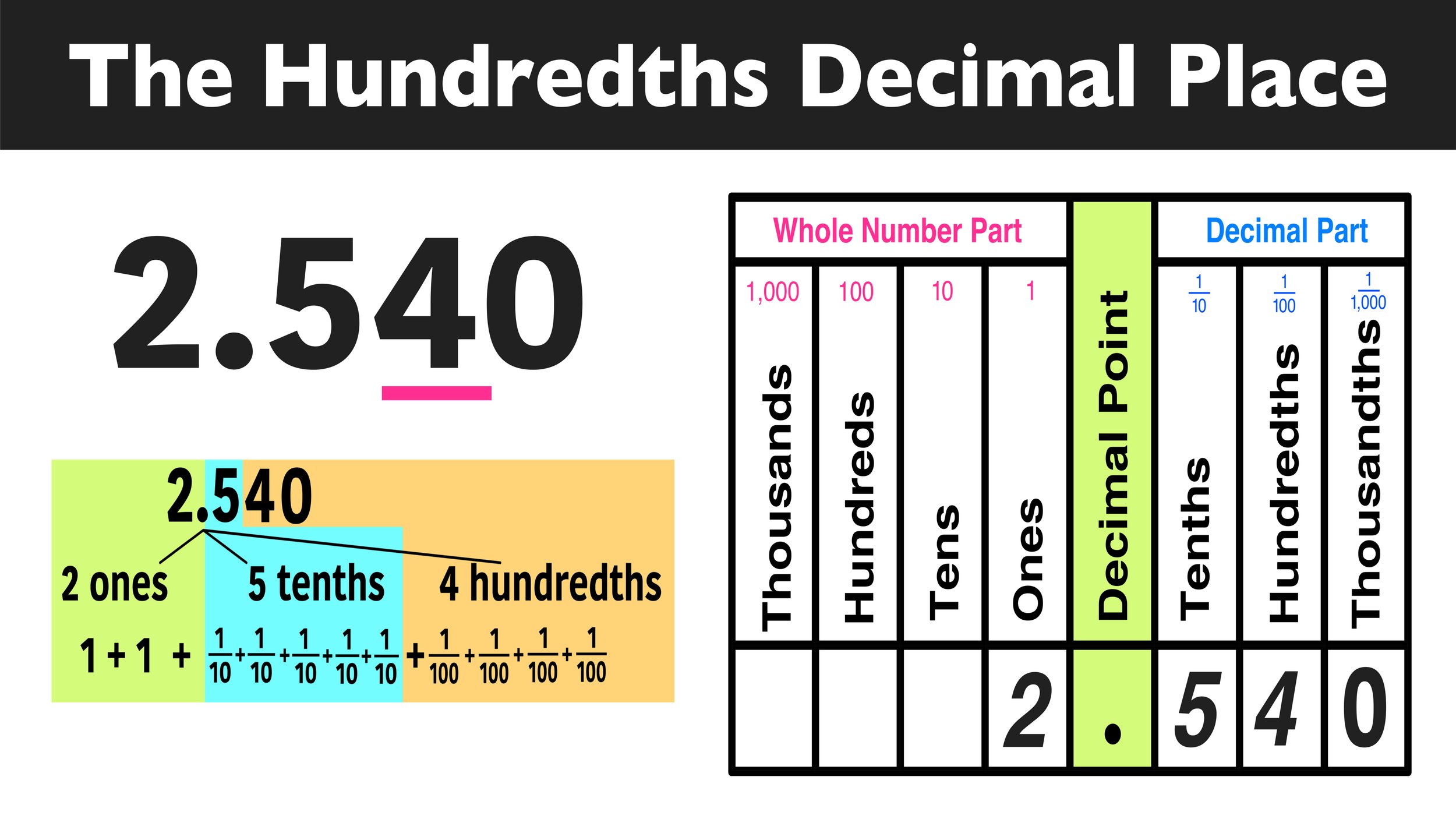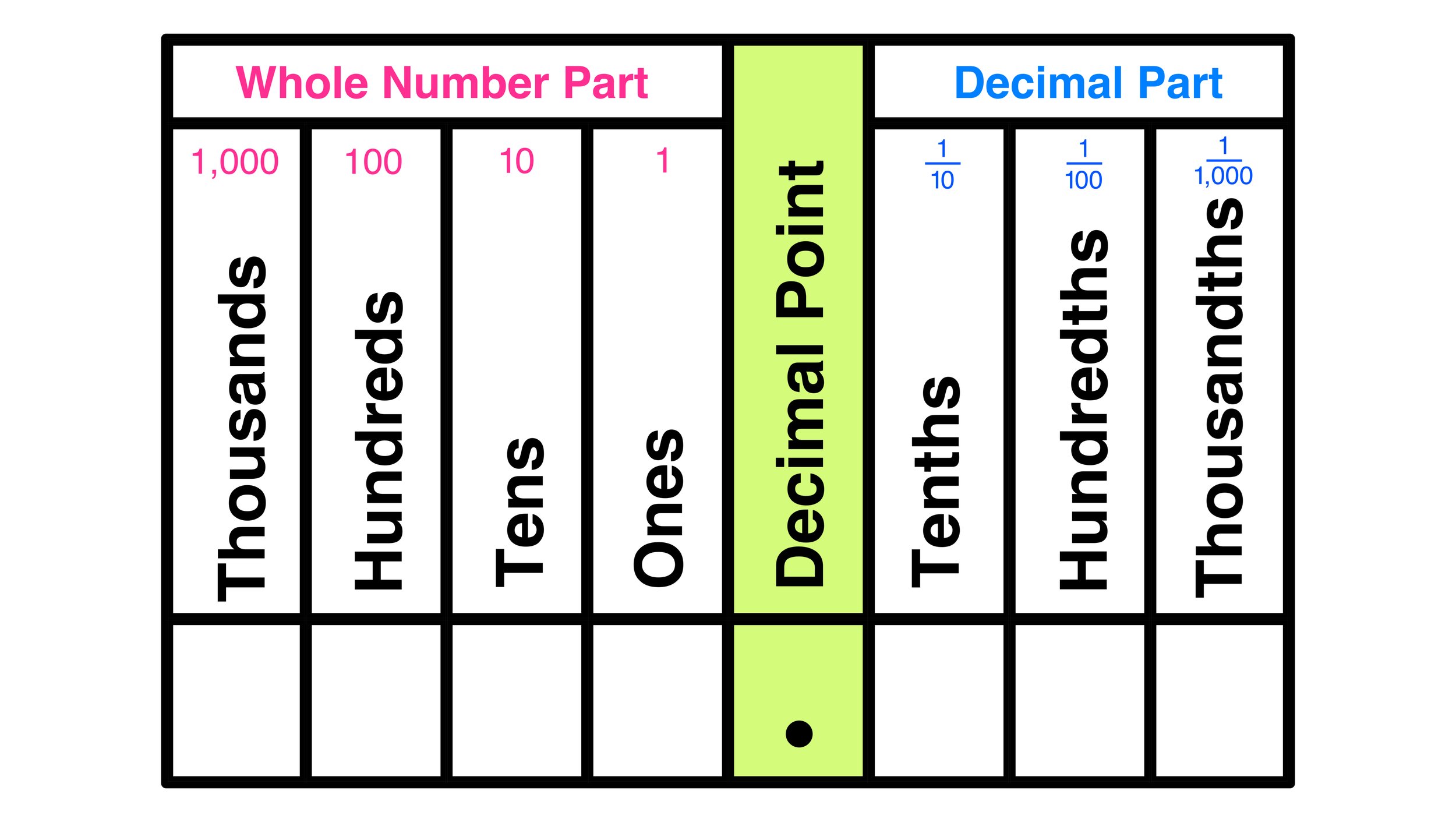Where is the hundredths decimal place in math?
In math, when we look at numbers, we can assign something called place value to each digit based on the position of each number.
When learning about and analyzing numbers—ranging from simple single-digit numbers all the way up to extremely large numbers that can have ten digits or more or—it is important that you understand the meaning of the significance of each digit’s place value, especially when decimals are involved.
When you first start learning about place value, determining each digit’s place value can be simple, especially when you are dealing with integers and decimals are not involved. However, once decimals are in play, identifying place value can get a bit trickier.
This free and simple guide for students will focus on the hundredths place and can be used as a quick review to help you along your place value journey when you start working with numbers involving decimals.
Once you understand place value, you will gain a deeper understanding of numbers—large and small—and your mental math and operational skills (performing addition, subtraction, multiplication, division, and more) will surely improve.
Are you ready to get started?
What is place value?
Before we learn about the hundredths place and what it means in terms of place value, let’s do a super quick review of some key vocabulary terms and some things that you may already know.
Definition: In math, place value refers to the numerical value that a digit has by virtue of its position in the number.
For example, consider the number 2.5.
We can think of the number 2.5 as the sum of 2 ones and 5 tenths.
So, in terms of place value, we can say that for the number 2.5:
2 is in the ones place
5 is in the tenths place
Pretty simple, right? Now, let’s extend this understanding of place value to the hundredths place.
What is the hundredths place?
In our last example, we looked at 2.5, which is a relatively simple decimal. As numbers grow larger, you will have to identify larger types of place values.
For example, consider the number 2.54.
We can express the number 2.54 as the sum of 2 ones, 5 tenths, and 4 hundredths.
So, in terms of place value, we can say that for the number 2.54:
2 is in the ones place
5 is in the tenths place
4 is in the hundredths place
In these previous examples, we are essentially deconstructing each number to identify the place value of each digit.
Note that the tenths place is different than the tens place and the hundredths place is different than the hundreds place.
The chart below shows you each place value position relative to a decimal point.
For example, consider the number 539.25
We can insert this value into the chart as follows:
Using the chart, we can clearly see that
5 is in the hundreds place
3 is in the tens place
9 is in the ones place
2 is in the tenths place
5 is in the hundredths place
Be sure not to confuse the hundreds place with the hundredths place!
Hundredths Decimal Place Examples
Now let’s go ahead and look at some more examples of determining which number is in the hundredths decimal place of a given number.
Example #1: Which digit is in the hundredths decimal place?
216.325
We can input this value into our chart as follows.
Using the chart, it is easy to see that the value in the hundredths place is 2.
216.325
Answer: 2
Example #2: Which digit is in the hundredths decimal place?
0.791
We can input this value into our chart as follows.
Using the chart, it is easy to see that the value in the hundredths place is 9.
0.791
Answer: 9
Example #3: Which digit is in the hundredths decimal place?
2,056.178
We can input this value into our chart as follows:
Using the chart, it is easy to see that the value in the hundredths place is 7.
2,056.178
Answer: 7
Example #4: Which digit is in the hundredths decimal place? 67.33333…
We can input this value into our chart as follows.
Using the chart, you can see that the hundredths place is 3.
Answer: 3
Example #5: Which digit is in the hundredths decimal place?
515.2
Notice that, at first glance, there is no value in the hundredths place.
However, 515.2 can also be expressed as 515.20
We can input this value into our chart as follows.
Using the chart, you can see that the hundredths place is 0.
Answer: 0
Extra Practice Problems
Which value is in the Hundredths Decimal Place?
By now, you should be more comfortable with identifying numbers occupying the hundredths decimal place.
Below, you will find 10 practice problems that will give you an opportunity to test your understanding of the hundredths place.
If you would like to use a chart to help you, click the link below to download a free blank place value chart!
▶ FREE DOWNLOAD: Decimal Place Value Chart (PDF File)
Practice Problems: Determine which number is in the hundredth place for each of the following:
(Answer key to follow!)
1) 2.75
2) 56.333
3) 8.18
4) 403.212
5) 5,009.15
6) 0.04
7) 0.0004
8) 76.5333
9) 565.404
10) 10,214.133
Finished? Don’t scroll further until you are ready to see the answer key.
Answer Key
1) 2.75
2) 56.333
3) 8.18
4) 403.212
5) 5,009.15
6) 0.04
7) 0.0004
8) 76.5333
9) 565.404
10)10,214.133
Conclusion: Hundredths Decimal Place
In math, each digit position in any given number has its own unique place value “slot.” These positions or “slots” are referred to as place value.
While determining place value positions for integers can be relatively simple, the identification process becomes trickier when decimals values become involved.
Using a chart can be a helpful tool to help you to correctly identify place value for numbers that one, two, three, or more digits after a decimal point.
Namely, the hundredths decimal place refers to the second digit to the right of the decimal point.




















